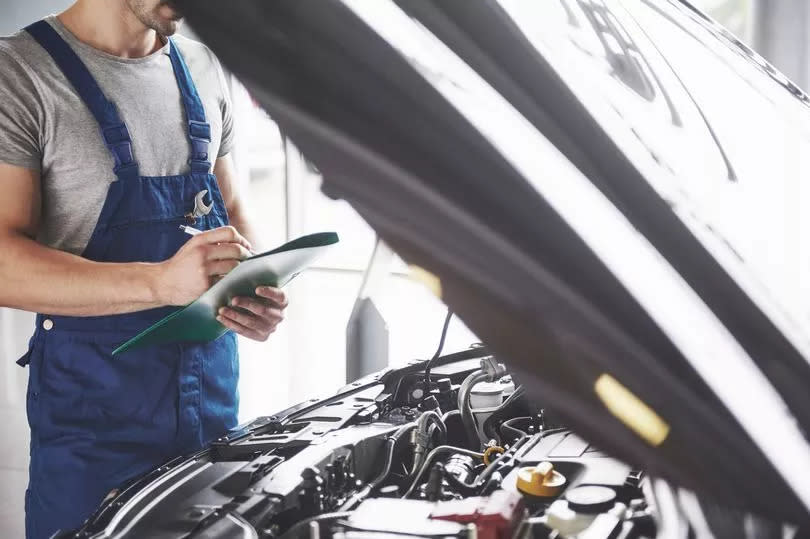'Be prepared' warning as major DVSA change made to MOT tests

On April 29, 2024, the Driving and Vehicle Standards Agency (DVSA) introduced the implementation of issuing all MOT test certificates digitally, marking a significant shift away from traditional paper certificates. For the first time, drivers will no longer be handed a piece of paper after the annual test.
The DVSA said that, over the previous year, 34.5 million MOT tests were conducted in the UK. To visualise this, if each A4 test certificate was laid out in a line, they would stretch for 4,500 miles, equivalent to 4,000 trees' worth of paper. With MOTs changing to a more sustainable approach from the DVSA, car warranty provider ALA Insurance has offered guidance on improving your chances of passing an MOT test and securing a digital certificate.
Callum Butler, from ALA Insurance, said: “The transition to digital MOT test certificates marks a big win for both convenience and environmental sustainability, streamlining processes while reducing paper waste. Among the most common pitfalls regarding MOT tests is overlooking regular maintenance. This includes neglecting to check essential components such as lights and suspension. Ensuring proper upkeep can significantly increase your chances of passing."
How to prepare your vehicle for an MOT
Check your lights and indicators work properly
Ensuring all lights work properly is crucial for the MOT test as defective lights can result in immediate failure. These checks are often overlooked as bulbs usually degrade gradually, leading drivers to assume they're fine if there are no immediate signs of malfunction.
Check over a vehicle's headlights, tail lights, brake lights, indicators, and fog lights. Clean the lenses to ensure maximum visibility. Promptly replace any faulty bulbs, and consider upgrading to long-lasting LED bulbs for better durability and visibility.
Ensure your tyres are safe and legal
Worn tyres can seriously compromise vehicle stability and safety, making them a significant concern for the MOT test. Tyre checks are commonly overlooked as drivers may miss signs of wear and tear, especially if the tyres appear to be in good condition at a glance.
Regularly check the tread depth of your tyres using a tread depth gauge or the built-in indicators, and replace tyres if the tread depth is below the legal limit of 1.6mm. Inspect each tyre for cuts, bulges, or uneven wear patterns, addressing any issues promptly. Lastly, check tyre pressure regularly and adjust according to manufacturer recommendations for optimal performance and fuel efficiency.
Maintain your brakes
Brakes are crucial for road safety, however if brakes appear to function, drivers can become accustomed to gradual wear and tear, leading them to overlook signs of brake degradation. Keep an eye on your brake system by regularly checking brake fluid levels and topping up if necessary.
Low brake fluid can indicate a leak or worn brake pads. Look over brake pads and discs for wear and replace pads if they are worn down to the minimum thickness, and test brakes for effectiveness and any unusual noises. Also, check the brake pedal feel, as a spongy or overly firm pedal may indicate air in the brake lines or worn brake components.
Look over the exhaust system for damage
A well-maintained exhaust system is essential for passing emissions tests during the MOT. However, issues with the exhaust system may be overlooked due to its complexity and drivers' limited understanding of its components.
Check the entire exhaust system for leaks, corrosion, or damage and promptly repair or replace damaged or rusted sections of the exhaust system if you have the necessary skills and tools. Ensure the exhaust system is securely mounted to the vehicle chassis for safety and adherence.
Repair chips and cracks in your windscreen
Windscreen chips or cracks can obstruct the driver's view and compromise vehicle safety, leading to MOT failure. Drivers may perceive minor chips as insignificant, especially if they don't obstruct their view.
Repair any chips or cracks in the windscreen promptly to prevent them from spreading. Check windscreen wiper blades for wear and tear, replacing them if they streak or leave residue on the windscreen. Ensure the windscreen washer system is functioning correctly, maintaining an adequate supply of washer fluid for clear visibility.
Check your suspension
Suspension components are vital for vehicle stability, comfort and safety, all of which are evaluated during the MOT test. This can be overlooked as drivers may not notice subtle signs of suspension wear.
Check suspension components for signs of wear, such as worn bushings, leaking shock absorbers, or damaged springs. Test the vehicle for excessive bouncing or swaying, which can indicate worn suspension components. Additionally, listen for any abnormal noises when going over bumps or uneven road surfaces, addressing any issues promptly to maintain optimal vehicle stability and comfort.

 Yahoo News
Yahoo News 
